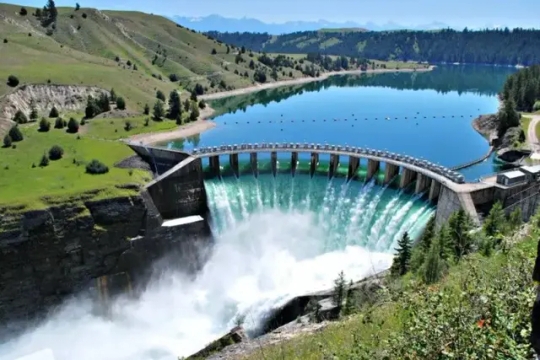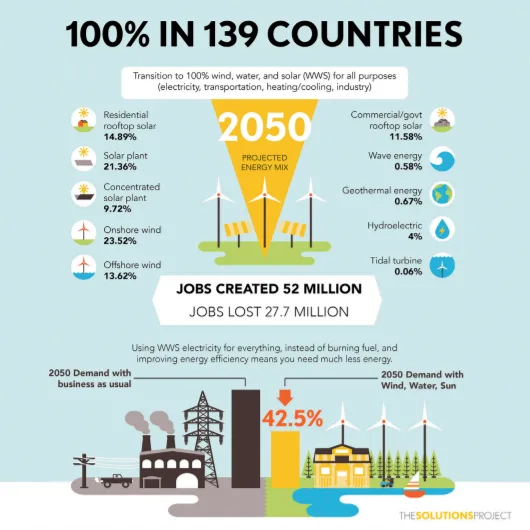#Costa Rica
Text
Costa Rica generates around 99 percent of its electricity from renewable sources. How was the country able to accomplish that?
Kenneth Lobo Méndez: The secret of this achievement is mainly planning.
Identify the capacity of the different energy sources so you can get the big picture about how different resources can work together to get a renewable system. In the winter, like a six-month period from June to December, many of the hydropower plants get surplus flows. That’s when we have low wind, but we have more hydropower. And then in the summer, like from December to May perhaps, we get low hydropower, so the other sources of energy complement that electricity supply — mainly wind power, biomass, and geothermal.
[...]
In the US, we’re used to many smaller private electric utilities. Does having a national energy company like ICE make it easier to adopt renewable energy?
KLB: In our perspective, yes, it’s an advantage that the planning is held by a government state company. It can make a plan for the country according to the government’s vision. We only sell what we need, and there’s no interference from different stakeholders. It makes the planning process more simple.
65 notes
·
View notes
Text

Scarlet macaws in Costa Rica
By Nick Garbutt
23 notes
·
View notes
Text






The jaguarundi is a relatively secretive species of medium-sized cat, native to the Americas. In many ways it resembles a large mustelid, but its closest relative is the cougar. It lives alone or occasionally in pairs in a large home range, and more often hunts in the day than other sympatric cats like ocelots.
©SilverSpot Productions
3K notes
·
View notes
Text

Costa Rica is a dream.
2K notes
·
View notes
Text
giant leaf katydid (Steirodon sp.) cleaning her antenna :)
#orthoptera#macrophotography#costa rica#katydid#video#ots#la selva#la selva biological station#bugs#bug#bugblr
4K notes
·
View notes
Text
rice and beans and cheese and avocados and tortillas and cinnamon and vanilla and cocoa and coffee and bananas and corn and

#idk what Latin Americans are doing but please PLEASE don’t stop I am begging#vanilla … VANILLA …. world changing. I’m losing my mind.#Colombia#peru#Brazil#costa rica#Mexico#puerto Rico#Latin America#coffee#planet earth#Latino#South America
15K notes
·
View notes
Text

Sebastian Tames
953 notes
·
View notes
Text

Baird's tapir Tapirus bairdii
With yellow-headed caracara Daptrius chimachima
Observed by infinitaselva
#Tapirus bairdii#Baird's tapir#Tapiridae#tapir#non-ungulate#bird#falcon#Daptrius chimachima#yellow-headed caracara#North America#Costa Rica
776 notes
·
View notes
Text

#nature#jurassic park#naturecore#aesthetic#naturewave#green#jungle#junglewave#foggy#forest#rainforest#costa rica#cottagecore#paradise#photography#adventure#travel#travelling#dinosaur#explore#woods#forestcore
880 notes
·
View notes
Text

Chestnut-billed Toucan (Ramphastos ambiguus) with leucism in Guápiles, Costa Rica
Photographed by Luis Solano Pochet
#upl#art#photography#wildlife photography#Chestnut-billed Toucan#Ramphastos ambiguus#Guápiles#Costa Rica#Luis Solano Pochet#animals#birds
454 notes
·
View notes
Text







Casa Serenidad, Monteverde, Costa Rica,
Courtesy: Monika Pancheva
#art#design#architecture#minimalism#interiors#interiordesign#luxuryhome#luxuryhouse#retreat#country house#concept#render#casa#casa serenidad#monteverde#costa rica#mid century#monika pancheva
441 notes
·
View notes
Text

Up in the trees.
284 notes
·
View notes
Text








Shining honeycreepers (Cyanerpes lucidus) in Panama and Costa Rica.
435 notes
·
View notes
Text
Countries That Generate 100% Renewable Energy Electricity

Pictured: Hydropower is the most widely used source of renewable energy-generated electricity. This dam is located near Polson, Montana.
Is 100% Renewable Resource-Generated Electricity Possible?
"With concerns growing regarding burning fossil fuels and their connection to global warming, a great debate is occurring regarding the feasibility of producing electricity entirely from non-carbon emitting green renewable energy sources such as geothermal, hydroelectric, wind, and solar. Skeptics and naysayers claim that achieving such a goal is impractical, would destroy the economy, and is in the realm of pie-in-the-sky thinking.
But is it actually impractical and unattainable? The answer is clearly "no" since there are already several countries that generate 100% of the electricity they use from renewable sources of energy. There are also many other countries that obtain over 90% of the electricity they use from renewable energy sources. Despite the negative rhetoric by some, there’s nothing impractical about using renewable energy to generate electricity on a grand scale.
The Countries Leading the Way to a 100% Renewable Energy Electricity Future
The following is a list of countries that are leading the world into the new frontier of economies that run their electrical grids either entirely or nearly entirely on renewable energy per a 2018 report by the International Renewable Energy Association (IREA) and the U.S. Energy Information Administration (EIA) statistics. This list and the percentages are subject to change over time, but it provides a good snapshot of just how practical renewable energy currently is for electricity generation.
Iceland obtains 100% of the electricity it needs from renewable energy sources. Iceland is somewhat unique since volcanic activity on the island provides a significant geothermal energy source that is utilized to provide approximately one-quarter of the country’s electricity. The remaining three quarters are provided by hydro-power.
Paraguay obtains 100% of the electricity it uses from renewable sources. Huge hydropower dams provide all of Paraguay's electricity needs, as well as supply neighboring Argentina and Brazil with electricity.
Costa Rica is another country leading the way towards 100% renewable-produced electricity. During 2018, Costa Rica met all of its electricity needs using renewable energy sources such as hydro-power, geothermal, biomass, wind, and solar for 300 days in a row.
Ethiopia, Kenya, Namibia, Norway, Tajikistan, and Uruguay are countries currently generating greater than 90% of the electricity they use from renewable energy sources. Some of these countries are working towards running their electric networks entirely from renewable energy.
Some things stand out from the list of countries leading the way in electricity generated from renewable energy.
They are relatively small countries.
They have abundant renewable natural resources, particularly abundant water resources available to generate hydro-power.
The list includes both wealthy developed and poor developing countries.
The fact that both developed wealthy countries and poor developing countries are leaders in renewable energy-produced electricity indicates that the cost of constructing renewable energy resources is not a limiting factor. In fact, developing countries can justify the capital cost of building renewable energy sources of electricity due to the fact that the operating costs are relatively low and predictable (not subject to commodity price swings), and renewable energy allows a country to be self-sufficient in meeting its electricity needs.
Large Developed Countries Can Also Produce 100% Of Their Electricity From Renewable Energy
Critics and naysayers might say that while these achievements by small countries are impressive, implementing renewable energy on a large scale is impractical for larger developed countries. But is it really impractical?
Cost and technological barriers are not what they once were for renewable energy. In fact, costs for renewable energy continue to decline year after year, and renewable energy technologies continue to develop and become more efficient. Many countries have not even come close to tapping their renewable energy potential or even tried some of the technologies available, such as electricity generated by wave or tidal power. Additionally, the argument that renewable energy is only useful when it is being generated is becoming irrelevant since large utility-scale batteries are now available that have the capability to store electricity generated by renewable energy and allow it to be used when needed.
Clearly, the answer is yes. Large developed countries can produce 100% of the electricity they need from renewable sources. It is only a matter of the will and investment at this point to make the changeover from fossil fuel-generated electricity to renewable energy electricity generation. The technical barriers are not as great as naysayers claim, as proven by smaller countries that have already reached the 100% threshold. Moving towards 100% renewable energy sources of electricity will become easier over time as wind, solar, and other renewables become more efficient and large utility-scale battery storage technologies become capable of storing larger quantities of energy for use when needed.

Pictured: Researchers lay out a plan for nearly 140 countries that could be powered 100 percent by renewable energy by 2050. spectrum.ieee.org
The City of Los Angeles Leads the Way in the U.S. With Inexpensive Solar
Various forms of renewable energy have experienced significant cost reductions to a point at which they are competitive and, in some cases, cheaper than traditional electrical energy sources such as coal, oil, and natural gas. This cost reduction trend will accelerate the change over to renewable sources of electricity. For example, the City of Los Angeles signed a deal in July 2019 for a large solar electricity array that will provide 7% of the city's electricity by 2025 at only two cents per kilowatt-hour (kWh). This is far cheaper than fossil fuel-derived electricity.
In addition to being cost-competitive, the practicality and reliability of renewable energy are poised to make major advances as large utility-scale battery technologies are rolled out that can be used to capture renewable energy when it is created, so the electricity can be used at a later time when needed. The Los Angeles solar array project includes utility-scale battery backup at a cost of 1.3 cents per kWh, so the electricity generated by the sun will be available even when the sun is not shining.
Los Angeles has a goal of achieving 100% renewable electricity generation by 2050. This solar contract is a big step toward achieving their goal."
-via TurboFuture, February 21, 2023
#renewables#renewablefuture#renewable energy#clean energy#green energy#solar power#solar panels#fossil fuels#climate crisis#climate change#global warming#hydropower#geothermal#wind power#wind turbines#iceland#paraguay#costa rica#ethiopia#kenya#namibia#norway#tajikistan#uruguay#united states#los angeles#battery#hope posting#hopepunk#sustainability
315 notes
·
View notes
Text

Samuel Brenes photographed by Jordan Ferreira
1K notes
·
View notes
